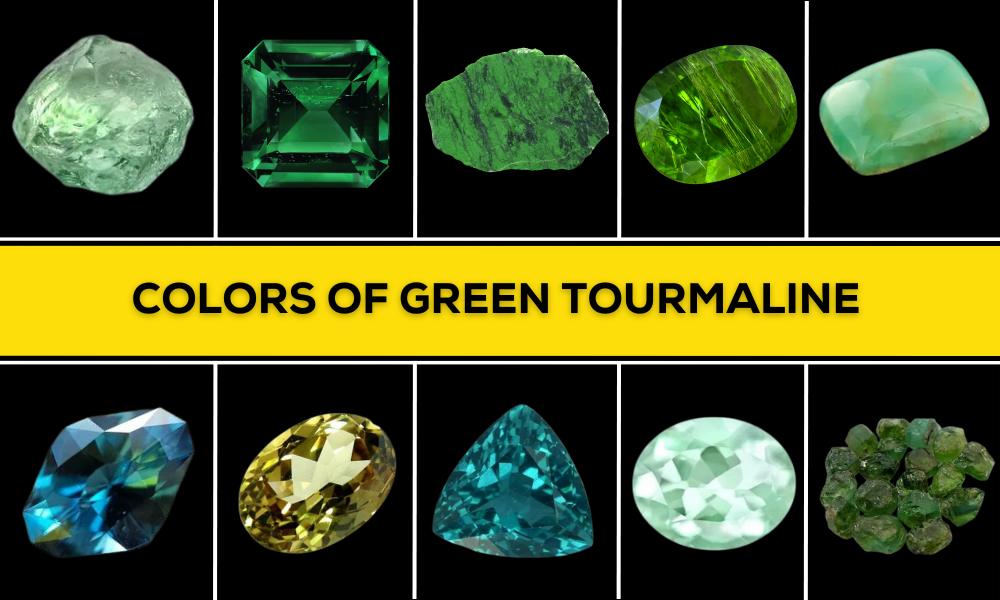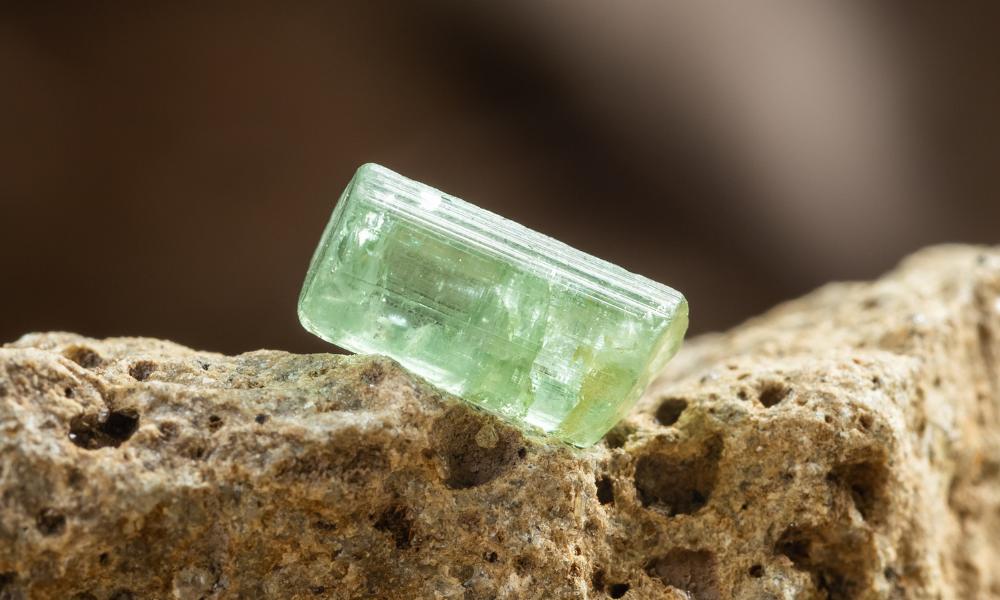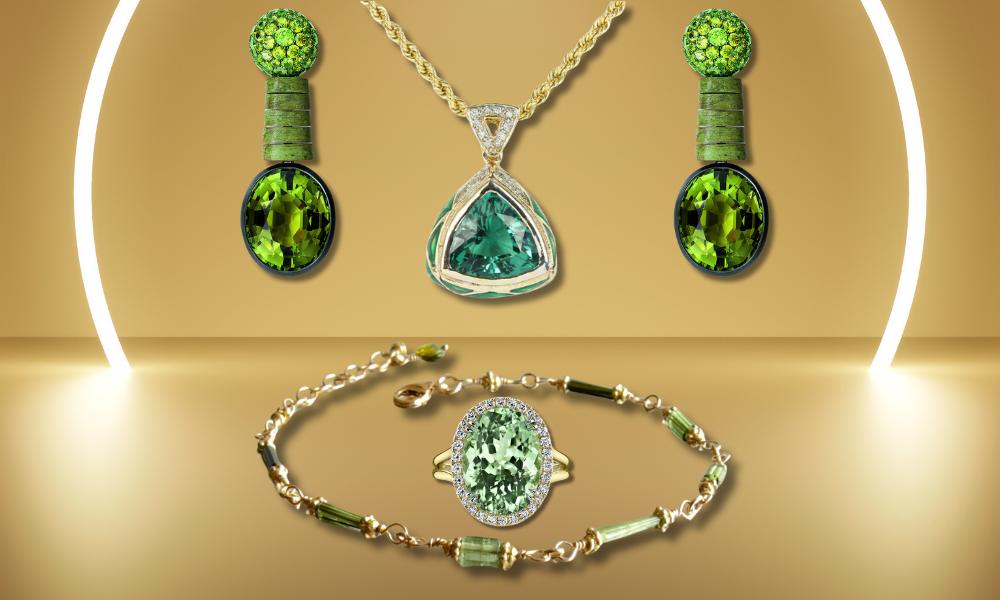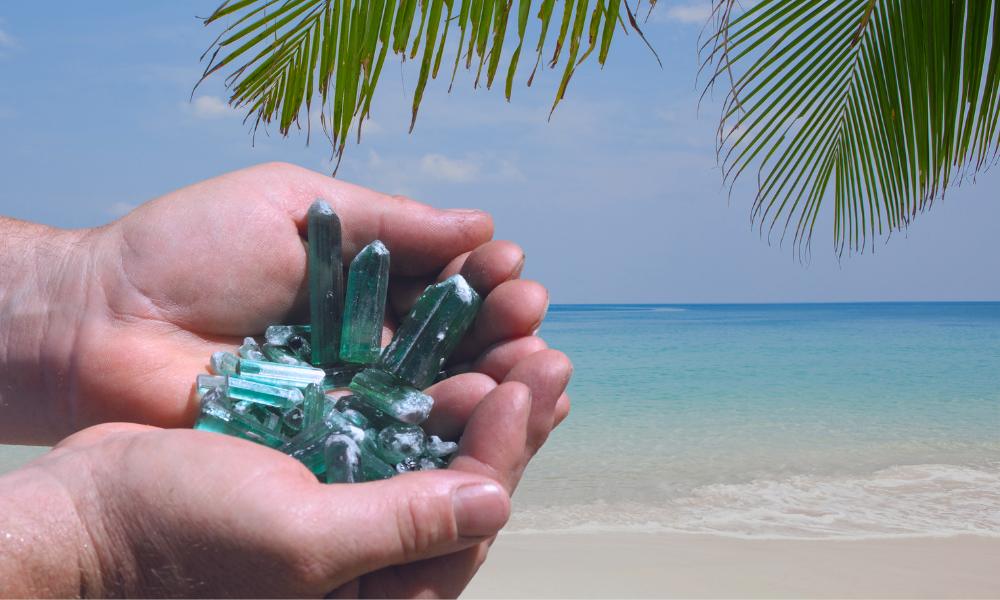The mineral group that contains various colored types of tourmaline includes green tourmaline as one of its varieties. Due to changes in its chemical makeup, tourmaline is a complicated aluminum borosilicate mineral that comes in a variety of colors. Iron and manganese are usually the culprits for the green hue of tourmaline.
But there’s a wide range even within the green tourmalines. Certain stones are extremely bright, while others are so dark that the green hue is only discernible when the stone is up against a light source. Intense yellowish-green, olive green, and brownish-green tones are also available in tourmalines, along with subtle leek tints. And the range of blue-green to dark bottle-green tourmalines is very lovely.
Table of Contents
Colors of Green Tourmaline

The mineral group tourmaline includes green tourmaline, which can have a range of green tones, from light and delicate to deep and vivid. Terms that express the shade and intensity can define the individual hues that make up the green spectrum. These tourmaline has the following common shades:
Mint Green
A pale green with chilly undertones that is similar to the hue of mint leaves.
Emerald Green
A rich, deep green that resembles the hue of emerald jewels.
Forest Green
A deeper, more muted shade of green, more akin to the hue of a thick forest.
Olive Green
A shade of green with hints of brown or yellow, similar to the hue of ripe olives.
Verdant Green
A deep, vivid green that is similar to the hue of well-maintained foliage.
Blue-Green
Certain green tourmalines may have a secondary blue tint, giving them a blue-green appearance.
Yellow-Green
Green tourmalines can occasionally have a yellowish undertone, giving them a yellow-green look.
Teal Green
A shade of green that is somewhat cyan or blue-based, similar to teal.
Seafoam Green
A light green that resembles the sea foam that covers the ocean’s surface.
Grass Green
A brilliant, bright green that resembles newly cut grass.
Varieties of Green Tourmaline

There are several types of green tourmaline, and each has special qualities of its own. These types are frequently categorized according to attributes like color, transparency, and occasionally even particular sites of origin. The following are some noteworthy tourmaline varieties:
Verdelite
It’s a common name for Green tourmaline. In the gem trade, it is one of the most widely used names for tourmaline, encompassing a variety of green hues.
Chrome Tourmaline
The striking green color that this type of green tourmaline exhibits is a result of chromium. Chromium is what gives it that vivid emerald-green color. Chrome tourmaline is famous for its vibrant hue.
Paraíba Tourmaline
There is a green variant of Paraíba tourmaline, while it usually has vibrant blue and green-blue colors. Paraíba tourmalines can have an amazing green hue and are highly valuable due to their neon-like tones.
Indicolite
Indolite can also refer to greenish-blue or bluish-green tourmaline. Any tourmaline that falls between blue and green is referred to by this phrase.
African Green Tourmaline
This word refers to tourmalines that come from different parts of Africa. Although the color might vary, rich, eye-catching tones are characteristic of African tourmalines.
Siberite
The particular color of this tourmaline type is pinkish to purplish-red. Siberite tourmalines, on the other hand, belong to the this tourmaline family because some of them may have a greenish tint.
Sources of Green Tourmaline

There are several places in the world where you can discover these tourmaline and certain regions are famous for producing tourmalines with unique qualities. Here are a few well-known places to find green tourmaline:
Brazil
Brazil is famous for producing some of the best green tourmaline. Particularly the state of Minas Gerais is famous for producing excellent tourmalines in a variety of colors.
Afghanistan
Afghanistan is a well-known supplier of tourmalines, particularly the green kinds. Beautifully saturated green tourmalines are a specialty of the Panjshir Valley.
Nigeria
Another important source of green tourmaline is Nigeria. The tourmaline deposits in the nation, especially in states like Oyo and Nasarawa, provide a variety of colors of these tourmaline.
Mozambique
Mozambique produces a range of colored tourmalines, including green ones. Due to their vivid colors and high clarity, the nation’s deposits have drawn interest from the gem industry.
United States
There are various places in the US where one can get these tourmaline. Green tourmalines of gem quality come from Maine in particular. Another state that is famous for producing tourmalines is California, particularly in the areas of Pala and San Diego.
Namibia
Tourmalines, especially green ones, are found in Namibia. Certain tourmalines from Namibia have distinct color zoning and distinctive qualities.
Pakistan
The gem-bearing regions of Pakistan are home to green tourmalines, one of the several colors of tourmaline that the country produces.
Madagascar
Green tourmaline is one of the many gemstones that may be found in Madagascar. The nation’s reserves of tourmaline support the international market.
Green Tourmaline Metaphysical Properties

Verdelite, another name for green tourmaline, is a kind of tourmaline that is usually green in hue. The following are some metaphysical qualities of these tourmaline:
Heart Chakra Activation
Green tourmaline opens and activates the heart chakra. This can promote compassion, empathy, and emotional equilibrium by improving one’s capacity to give and accept love.
Emotional Healing
By assisting in the release of unpleasant emotions, traumatic experiences, and ingrained emotional patterns, green tourmaline promotes emotional healing. It might promote self-love and inner tranquility.
Attracting Prosperity
There are others who think that these tourmalines can draw wealth and success. It cultivates an upbeat, cheerful outlook that draws luck.
Enhancing Creativity
This tourmaline, like other tourmaline hues, fosters creativity. It might inspire creativity and enable people to express themselves more freely.
Balancing and Harmonizing
Green tourmaline balances the body, mind, and spirit. It might support general well-being by assisting in the subtle energy centers’ alignment and balance.
Strengthening the Nervous System
According to many customs, tourmaline has qualities that help the neurological system. It provides a relaxing effect that eases tension and stress.
Spiritual Growth
This tourmaline might promote spiritual development. It might promote a closer relationship with nature, sharpen intuition, and make spiritual revelations easier.
Protection and Purification
Green tourmaline offers protection from harmful energies in addition to its heart-centered qualities. It erects a barrier around the person, keeping negative influences out.
Green Tourmaline Jewelry

Green tourmaline is a stunning gemstone that is frequently used in jewelry due to its vivid green hue. The following are some typical varieties of the tourmaline jewelry along with some things to think about when choosing or maintaining them:
Rings
Whether used alone or in conjunction with other gemstones, green tourmaline is frequently the main stone in rings. Tourmaline rings are a popular choice for statement pieces or engagement rings.
Earrings
There are many different types of green tourmaline earrings, such as studs, hoops, and dangles. They go well with both professional and casual attire because they are a flexible option.
Necklaces and Pendants
Tourmaline pendants are worn on necklaces and set in a variety of metals, such as silver or gold. Depending on the desired shape, the stone may be sliced into an oval, round, or pear shape.
Bracelets
The gemstone can take center stage in green tourmaline bracelets or we can incorporate it into a more elaborate design. Tourmaline beads are also a popular choice for beaded bracelets.
Birthstone Jewelry
One of the birthstones for October is green tourmaline. Choose this tourmaline when honoring someone’s birthday this month.
Take into account the following factors when choosing tourmaline jewelry:
Color
There are a range of green tones in tourmaline, from light to dark. The rich and vivid greens are the most expensive and sought-after hues.
Clarity
Although many gemstones are treated to improve clarity, tourmaline is not immune to impurities. While some value natural crystals for their distinctiveness, others like stones with fewer inclusions.
Cut
The cut influences the tourmaline’s brilliance and general look. People frequently use round, oval, pear, and emerald cuts.
Setting
Take into consideration the jewelry’s metal setting. Popular options include rose gold, white gold, yellow gold, and silver. The setting style might be anything from sophisticated and traditional to modern or complex.
Care
Although tourmaline is a hard gemstone, you must take good care of your jewelry. Keep it away from strong chemicals, very hot or cold temperatures, and ultrasonic cleaning techniques. Use a gentle cloth and some light soap to clean it.
Taking Care of Green Tourmaline

Although tourmaline is a fairly hard gemstone, it requires regular maintenance to keep its beauty throughout time. The following advice may help you maintain your tourmaline jewelry:
Avoid Harsh Chemicals
Green tourmaline can become damaged by exposure to strong chemicals. Before doing any tasks that require you to come into touch with chemicals, such as cleaning supplies, chlorine, or powerful detergents, take off your jewelry.
Avoid High Temperatures
High temperatures can cause tourmaline to become sensitive. Refrain from subjecting your jewelry to intense heat sources, such as steam rooms or hot tubs.
Protect from Scratches
Despite its relative hardness, harder materials can nevertheless scratch tourmaline. To avoid scratches, keep your jewelry with tourmaline apart from other items. Use a jewelry box with separate sections or velour pockets if possible.
Gentle Cleaning
To keep your tourmaline jewelry shining, give it a regular cleaning. Using a soft brush or cloth, gently scrub the gemstone with a mild soap and warm water solution. Refrain from using brushes or harsh cleaners that can scratch the surface.
Ultrasonic and Steam Cleaning
Although tourmaline can withstand steam and ultrasonic cleaning, care must still be taken. These techniques may have an impact on inclusions or fractures in certain stones. Seek advice from a qualified jeweler before using steam or ultrasonic cleaning equipment.
Storage
Keep your tourmaline jewelry in a dry, cool area while not in use. It may fade if you leave it out in the sun for extended periods of time.
Avoid Impact
Despite its relative toughness, tourmaline is nonetheless susceptible to chipping or cracking from hard impacts. Before participating in any impact-prone activity, such as sports or strenuous manual labor, take off your jewelry.
Regular Inspection
Check your tourmaline jewelry from time to time for wear indicators, loose stones, and broken prongs. Bring your jewelry to a qualified jeweler for assessment and possible repairs if you find any problems.
Professional Cleaning
At least once a year, think about getting your tourmaline jewelry professionally cleaned and inspected. Jewelers can professionally clean your jewelry and check for any faults that might need to be addressed to keep it looking its best.
(FAQs) about Green Tourmaline
Q1. What is green tourmaline for?
Green Tourmaline is an extremely potent healing stone. It stabilizes and balances the heart’s energy field, which contributes to heart harmony. Additionally, it strengthens the heart and facilitates the body’s natural flow of healing energy by aligning the electromagnetic field of the heart with that of the Earth.
Q2. Is green tourmaline valuable?
The most precious stones are those that exhibit appealing colors in both orientations, such as vivid green in one and blue in another. Compared to most these tourmalines, chrome tourmaline stones have more intense colors.
Q3. Who can wear green tourmaline?
Green tourmaline gemstones are advised by Vedic astrology for Mithun (Gemini) and Kanya (Virgo) Rashies. According to Western astrology, the birthstone for October babies is green tourmaline. Wearing green tourmaline crystals is also appropriate for the signs of Aries, Cancer, Leo, and Scorpio.
Q4. Why is tourmaline so expensive?
Additionally extremely rare are tourmalines that change color. Particularly sought-after are the emerald-green chrome tourmalines, raspberry-red rubellites, and neon-blue paraíba tourmalines. Clean gemstones are highly valued, particularly those weighing more than 10 carats because tourmaline crystals are prone to cracking and flaws.
Q5. Why is tourmaline so special?
From the Renaissance to the Victorian era, artists and writers frequently employed tourmaline as a talisman, believing it to stimulate creativity. Pink tourmaline is the rarest color in the tourmaline family. It is even more uncommon than a ruby!
Stay Tuned to Gems Tycoon for all gems-related articles.









